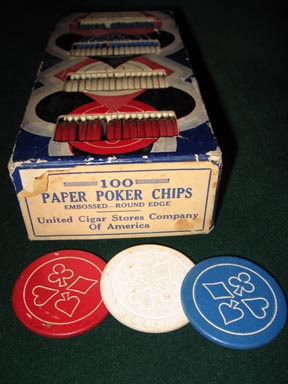|

In the 1870's Ivory was all the rage and poker chips and dice were made of this material. Ivory poker chips can readily be found today and I would suggest that if you are in the market for an Ivory Chip or two, pay the extra cost for one that has no defects i.e. no cracks or nicks.
Things you should know about Ivory: there is Elephant Ivory, Mammoth Ivory, Hippo Ivory and Walrus Ivory.
Elephant and Mammoth Ivory has the tall-tale cross-hatch "X" pattern. Hippo Ivory has a pattern similar to growth rings of a tree and Walrus Ivory has a "crushed ice" look that sets Walrus apart from all other Ivories. Synthetic Ivory does not have this cross-hatch pattern.
 |
| Chip made of clay |
The cost of Ivory and the cost to manufacturer Ivory Poker Chips made them expensive for that time. So much so that by the 1880's "Composition Chips" became the norm. A "Composition Chip" is a chip made of man-made materials. Celluloid, actually Cellulose Nitrate, an early synthetic polymer is one such man-made material. Celluloid was made from gun cotton and camphor and when is a pure state resembled ivory in texture and color. Celluloid is also know as; Parkesine, Pyroxiline, Xyloidin, Xyloidine, Xylonite and Zylonite.

By the 1890's many of those small burgs, the mining camps and cattle towns had either turned into ghost towns or grown into cities. Once they became a city they were able to stand on their own and no longer needed gamblers and gambling joints to support them. The reformers had always been around in one form or another but the town fathers spent their time pandering to the reformers, never really taking their concerns seriously because the gamblers were a necessity. But once the cities no longer needed gambling the reformers were now in vogue. Laws were passed and gambling was outlawed in city after city. Now the gamblers weren't about to just give up so they moved behind closed doors. The "ringing" in of composite chips made it easy for officials to discover these illegal games and raid them. The gamblers needed a quieter chip and manufacturers quickly responded. Chips made of rubber, wood and paper were soon available. Gambling thrived behind closed doors and all was well with the world. Well, at least for awhile.
You can find wood and paper chips today in most any Antique Shop. They have little value, in fact, the box may be worth more than the chips but it's nice to have a box or two because they help complete a collection. Especially when you understand there purpose and place in history.
This brings us to the turn of the century and Bakelite. First introduce in 1909, Bakelite is a synthetic resin formed by the reaction under heat and pressure of phenol and formaldehyde and a wood flour filler.

|